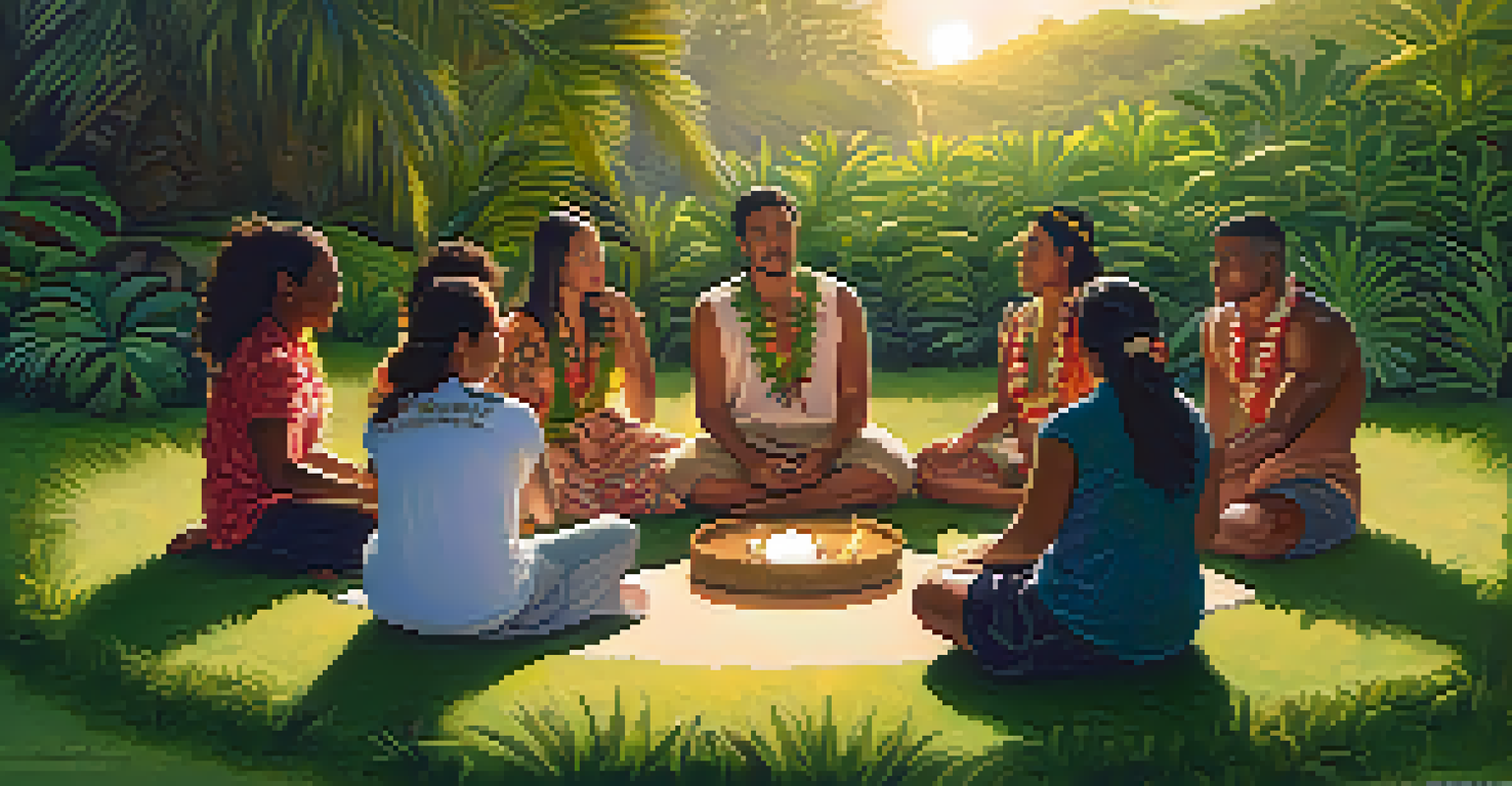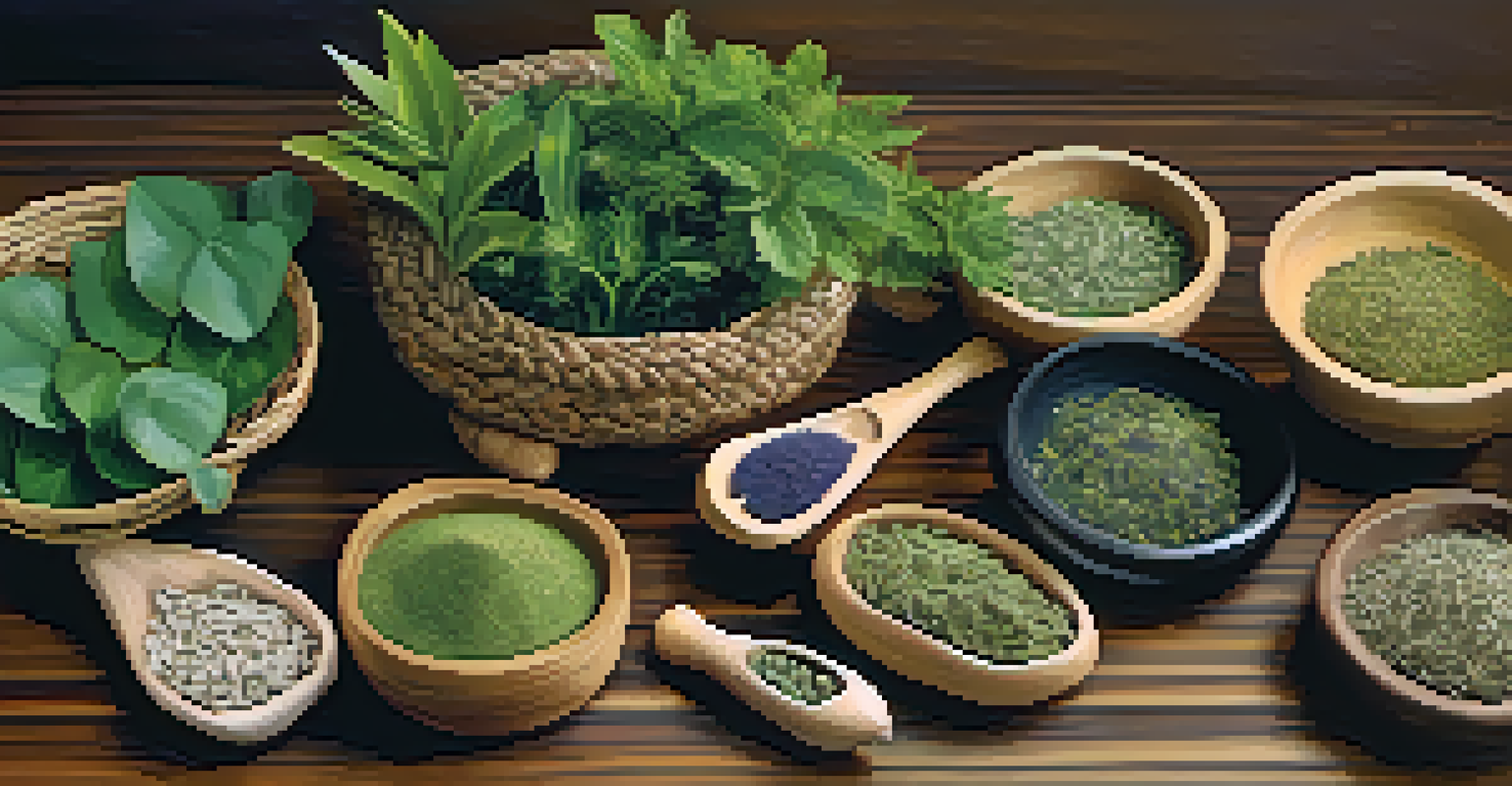Traditional Hawaiian Healing Practices: A Holistic Approach

Understanding Traditional Hawaiian Healing Practices
Traditional Hawaiian healing practices, known as 'Laʻau Lapaʻau', are deeply rooted in the culture and spirituality of the islands. These practices emphasize a holistic approach to health, integrating the body, mind, and spirit. Unlike Western medicine, which often focuses on treating symptoms, Hawaiian healing seeks to understand the underlying causes of illness, promoting overall well-being.
Healing is a matter of time, but it is sometimes also a matter of opportunity.
At the core of these practices is the belief in 'mana', or life force energy, which flows through all living things. Healers, or 'kahu', utilize various techniques to restore balance and harmony within an individual. This perspective encourages individuals to connect with their environment and community, fostering a sense of belonging and support.
Hawaiian healing is not just about physical health; it also incorporates emotional and spiritual aspects. Treatments may include herbal remedies, massage, and rituals that honor ancestors and the natural world. By addressing all facets of a person's life, these practices aim to create a comprehensive path towards healing.
The Role of 'Kahuna' in Hawaiian Healing
'Kahuna' refers to skilled practitioners who have mastered traditional Hawaiian healing arts. These healers play a crucial role in the community, serving as guides and teachers in the journey toward health. They possess extensive knowledge of plants, rituals, and spiritual practices that have been passed down through generations.

Each kahuna specializes in different areas of healing, such as physical ailments, spiritual guidance, or emotional support. Their training often includes years of apprenticeship, where they learn the intricacies of the practice and the significance of their work. This deep connection to tradition ensures that the healing methods remain authentic and effective.
Holistic Hawaiian Healing Practices
Traditional Hawaiian healing emphasizes a holistic approach that integrates the body, mind, and spirit to promote overall well-being.
Kahunas often use a combination of techniques, including 'ho'oponopono', a practice focused on forgiveness and reconciliation. This approach not only addresses individual health but also promotes harmony within families and communities. By fostering relationships and understanding, kahunas help individuals heal on multiple levels.
Herbal Remedies in Hawaiian Healing
Herbal remedies are a cornerstone of traditional Hawaiian healing practices. The islands are home to a rich variety of plants, many of which have been used for centuries to treat various ailments. Healing herbs such as 'noni', 'awa', and 'kava' are not just remedies but are also imbued with cultural significance and respect.
The greatest medicine of all is to teach people how not to need it.
These natural remedies are often prepared in unique ways, including teas, poultices, or oils, tailored to the individual's needs. Healers carefully select herbs based on their properties and the specific health concerns of the patient. This personalized approach ensures that the treatment aligns with the individual's unique constitution and circumstances.
Moreover, the use of herbal remedies is intertwined with spirituality. Many practitioners believe that the plants convey their own 'mana' or healing power. Thus, the process of gathering and preparing these herbs is often treated as a sacred ritual, further enhancing their effectiveness and significance in the healing journey.
The Significance of 'Ho'oponopono'
'Ho'oponopono' is a traditional Hawaiian practice focused on conflict resolution and forgiveness. The term translates to 'to make right' and emphasizes the importance of restoring harmony within oneself and with others. This practice is often facilitated by a kahuna, who guides participants in expressing feelings and finding resolution.
The process typically involves open communication, reflection, and the expression of love and gratitude. Participants are encouraged to acknowledge their roles in conflicts, fostering accountability and understanding. This not only aids in healing personal relationships but also promotes emotional well-being and mental clarity.
Role of Community in Healing
The concept of 'ohana' highlights the importance of community support in the healing process, reinforcing that collective health benefits everyone.
By incorporating ho'oponopono into healing practices, individuals can release negative emotions and cultivate a more positive outlook. This holistic approach highlights the interconnectedness of mental, emotional, and spiritual health, echoing the broader principles of traditional Hawaiian healing.
Spiritual Aspects of Hawaiian Healing
Spirituality plays a vital role in traditional Hawaiian healing practices. The Hawaiian worldview emphasizes the connection between individuals and their ancestors, the land, and the universe. This interconnectedness fosters a sense of belonging and purpose, which is essential for holistic healing.
Many healing practices incorporate prayers, chants, and rituals that honor ancestors and the spiritual realm. These elements create a sacred space for healing, allowing individuals to tap into their spiritual resources. This aspect of healing encourages a deeper understanding of one's identity and place within the larger community.
Furthermore, the spiritual component of Hawaiian healing often serves as a source of strength and guidance. By engaging with spiritual practices, individuals can find comfort and support during challenging times. This connection to something greater serves to empower individuals on their healing journey.
The Importance of Community in Healing
Community is a fundamental aspect of traditional Hawaiian healing practices. The Hawaiian concept of 'ohana', meaning family, extends beyond biological connections to include friends, neighbors, and the broader community. This sense of belonging is crucial for emotional and spiritual well-being.
In Hawaiian culture, healing is often a collective process, with community members coming together to support one another. This can manifest in group healing sessions, shared meals, or communal rituals that reinforce bonds and promote collective health. The idea is that when one person heals, the entire community benefits.
Respecting Cultural Significance
Integrating Hawaiian healing into modern wellness requires a respectful understanding of its cultural significance and traditions.
This communal approach also fosters a network of support, making it easier for individuals to seek help and share their experiences. By emphasizing the importance of connection, traditional Hawaiian healing practices remind us that we are never alone in our struggles, and that healing can be a shared journey.
Integrating Hawaiian Healing into Modern Wellness
As interest in holistic health continues to grow, many individuals are exploring ways to integrate traditional Hawaiian healing practices into their modern wellness routines. These practices offer a unique perspective on health, emphasizing balance, connection, and the importance of nurturing the body, mind, and spirit. This integration can enhance overall well-being and provide valuable insights into personal health.
Incorporating elements like herbal remedies, mindfulness practices, and community support can create a more enriched wellness experience. For instance, individuals may choose to participate in ho'oponopono workshops or explore the benefits of traditional Hawaiian herbs. By embracing these practices, people can cultivate a deeper understanding of their health and well-being.

However, it's essential to approach these practices with respect and an understanding of their cultural significance. Engaging with local practitioners and learning about the traditions can foster a genuine appreciation for Hawaiian healing. This respectful integration not only enriches personal wellness but also honors the heritage and wisdom of Hawaiian culture.